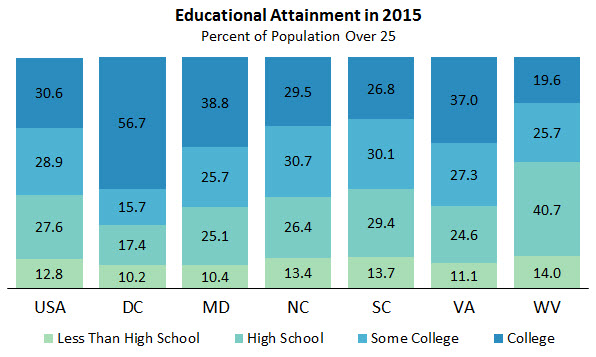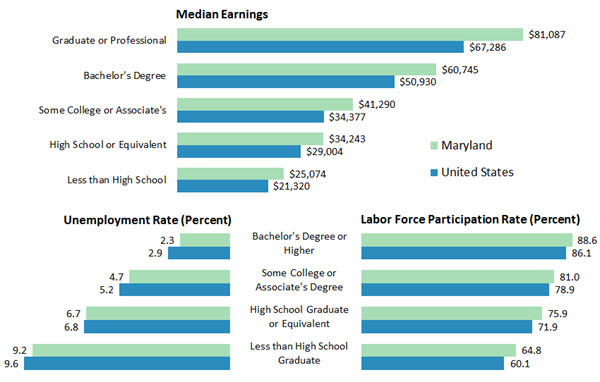Educational Attainment in the Fifth District
Each year, the Census Bureau interviews more than 2 million people for the American Community Survey (ACS). This survey collects data on demographics, employment, education, and other personal characteristics from the nation’s population. In our new report, we use this information to look at earnings, unemployment, and labor force participation by educational attainment across the Fifth District. We also look at educational attainment across race, sex, age, and geographic area.
There are significant differences among states in educational attainment (as shown in the chart below). The District of Columbia is somewhat unique, with nearly 57 percent of the population over 25 having a bachelor’s degree or higher. This is much higher than the national rate of 30.6 percent. In West Virginia, on the other hand, high school or equivalency is the highest level of education for nearly 41 percent of the population, compared to about 25 percent in Virginia.
Every state in the nation, however, has seen a steady rise in education levels over the last 45 years. In the 1970 Decennial Census, only 10.7 percent of people in the United States had a four-year college degree, and 47.6 percent had less than a high school diploma. Compare this to the 2015 ACS, where the frequency of bachelor’s degrees nearly tripled to 30.6 percent, and only 12.8 percent had a high school diploma or less.
Another important use of the ACS data is to highlight the connection between higher education and higher wages. As shown in the graphs below for the United States and Maryland, higher levels of education correspond with higher median earnings. The median annual earnings for someone with a graduate or professional degree in the United States are more than three times as high (over $67,000) as the earnings of those with less than a high school degree (less than $22,000).
Using data from the ACS for the population over 25, we calculate unemployment and labor force participation rates, revealing that educated people are more likely to participate in the labor force and less likely to be unemployed. The unemployment rate for those in the United States with a bachelor’s degree or higher is only 2.9 percent, less than half of the 6.8 percent unemployment rate for those with only a high school diploma or equivalent. In the United States, labor force participation ranges from a high of 86.1 percent for those with a bachelor’s degree or higher to a low of 60.1 percent for those with less than a high school education. These same trends are present across states in the Fifth District.
The breakdown of education by age and sex shows that young women have higher rates of education than older women. For example, across the United States, 21.2 percent of women age 65 and older have a bachelor’s degree or higher. On the other hand, 38.1 percent of women aged 24 to 35 have a bachelor’s degree or higher. For men, on the other hand, college education rates are almost the same across age groups.
As the labor and earnings numbers show, there is good reason to care about education rates, as they are closely linked to earnings and employment status. To see the data referenced here, and other statistics on educational attainment in the Fifth District, please check out our new reports.
Have a question or comment about this article? We'd love to hear from you!
Views expressed are those of the authors and do not necessarily reflect those of the Federal Reserve Bank of Richmond or the Federal Reserve System.



